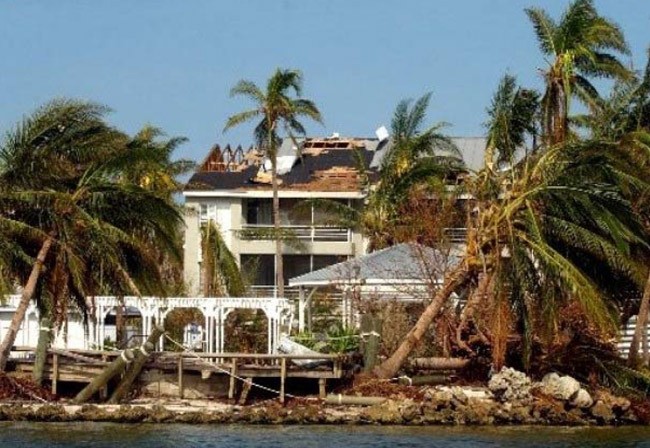
Flagler County’s Emergency Services division is broadening the pool of money available to residents, businesses and local governments looking to strengthen homes and commercial structures against major storms, floods and other hazards.
Some of the money to residents is available as grants: money that doesn’t have to be refunded. Another pool of money is available as loans, but those loans are not contingent on credit histories, making them more accessible to candidates with poor credit.
Earlier this month, for example, the emergency division secured $233,000 in a no-match grant that, once ratified by the county commission, will be available to low and moderate-income residents anywhere in the county and its cities. It’s called the Residential Construction Mitigation Program, or RCMP. It’s entirely state-funded: homeowners need not put up a dollar, nor repay the grant, if they qualify. They can apply to repair or strengthen roofs and gables, install hurricane straps and anchor walls or structures to the ground, among other improvements. Those who qualify and carry out the improvements will see their home insurance premiums drop.
“We hope that we’ll get more people interested in this program than we’ll able to fund with this initial amount of money,” says Laura Nelson, the Flagler County emergency planner who secured the grant less than two weeks ago, among the more than $1 million in grants she’s secured this year.
The parameters of the mitigation program dollars haven’t yet been issued, but the grant, and several other sources of similar, so-called mitigation dollars, were discussed in a meeting of emergency services personnel with representatives of local governments last week. The meeting was designed to broaden understanding of “mitigation” programs and make mitigation itself a more accessible word in the local landscape of emergency management.
“I want to make it a term people understand,” Nelson said, framing her explanation in terms of money that can be channeled to local governments.
Another program that could be directly beneficial to residents and businesses is loan-based: the Property Assessed Clean Energy program, or PACE, targets property owners who need to make improvements on a range of things (including replacing air conditioning units, water heaters, roofing, storm shutters) but are either short on cash or can’t secure bank loans. PACE financing is provided to qualifying homeowners without basing the loan on credit histories. To qualify, homeowners must have no delinquencies, be the owner of record, be current on taxes, have no liens and no bankruptcies in the last three years, and no foreclosures, though the latter two requirements are flexible.
“This is another funding source for property owners to augment cash, augment grants to get mitigation done,” Mark Pierson, who presented the program at the emergency division’s mitigation meeting last week, said. “That makes it essentially a non-credit based loan for property owners in the area.” PACE is entirely separate from the local emergency infrastructure: it’s a non-profit agency formed in 2011 by Kissimmee and Flagler County to tap into dollars available for loans. Barbara Revels, the county commissioner, sits on the PACE board. “We’re actually a unit of local government,” Pierson said.
Beyond those two programs, Nelson outlined a series of additional grant and mitigation programs available to governments agencies that want to improve their public buildings’ resistance to disasters. The programs don’t have recognizable names—Hazard Mitigation Grant Program, Flood Mitigation Assistance Grant program, Pre-Disaster Mitigation program—but in every case, the programs add up to pools of money that local cities and government agencies can compete for, through emergency management, to bring in money that can underwrite existing needs without diminishing local coffers.
An example: Hazard Mitigation Grant program dollars totaling almost $120,000 were secured to retrofit Fire Stations 51 and 71.

“We have to have our fire departments, we have to have our public works departments, we have to have our law enforcement officers. We have no law enforcement here whatsoever, and all of them are considered critical infrastructure key resources,” Guthrie said at the meeting last week, stressing that almost every local agency has mitigation needs. “We’re going to do this program. I’ve committed to it, I’ve gone out and sought the number one planner in the state to get this done, and I think my investment has paid off exponentially, because not only did we get her, she’s brought in $1.1 million to this community in the last year. I’ve bought in, I’ve asked you guys to buy in with me, and we’re going to do this regardless of who’s in the room. So if it only ends up being us, then we’ll bring home money for us, all the others will be on the others looking in, and I hate to say it, that’s what it is at the end of the day.”
Guthrie referred to Nelson as the county’s “mitigation planner without borders,” tapping into money that could be used by every city and local government agency, whether to buy emergency power generators or strengthen a school’s emergency-shelter structure—as long as those agencies are represented.
“We’ve got to have fire chiefs sitting in this room,” Guthrie insisted. “We’ve got to have law enforcement personnel sitting in this room to help us get that type of stuff. I cannot reiterate that enough.” (The meeting was attended by every local city, the forest service, Flagler County schools and the county.)




























tomc says
Lots of $ for government agencies and the “poor”. Will there be anything for ordinary, hard working, taxpayers?